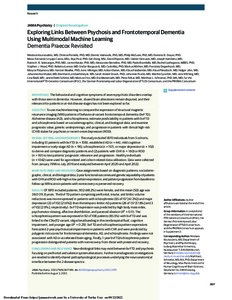Exploring Links Between Psychosis and Frontotemporal Dementia Using Multimodal Machine Learning Dementia Praecox Revisited
Koutsouleris Nikolaos; Pantelis Christos; Velakoulis Dennis; McGuire Philip; Dwyer Dominic B.; Urquijo-Castro Maria-Fernanda; Paul Riya; Dong Sen; Popovic David; Oeztuerk Oemer; Kambeitz Joseph; Salokangas Raimo K. R.; Hietala Jarmo; Bertolino Alessandro; Brambilla Paolo; Upthegrove Rachel; Wood Stephen J.; Lencer Rebekka; Borgwardt Stefan; Maj Carlo; Nöthen Markus; Degenhardt Franziska; Polyakova Maryna; Mueller Karsten; Villringer Arno; Danek Adrian; Fassbender Klaus; Fliessbach Klaus; Jahn Holger; Kornhuber Johannes; Landwehrmeyer Bernhard; Anderl-Straub Sarah; Prudlo Johannes; Synofzik Matthis; Wiltfang Jens; Riedl Lina; Diehl-Schmid Janine; Otto Markus; Meisenzahl Eva; Falkai Peter; Schroeter Matthias L.; International FTD-Genetics Consortium (IFGC); the German Frontotemporal Lobar Degeneration (FTLD) Consortium; and the PRONIA Consortium
https://urn.fi/URN:NBN:fi-fe2022091258743
Tiivistelmä
Importance
The behavioral and cognitive symptoms of severe psychotic disorders overlap with those seen in dementia. However, shared brain alterations remain disputed, and their relevance for patients in at-risk disease stages has not been explored so far.
Objective
To use machine learning to compare the expression of structural magnetic resonance imaging (MRI) patterns of behavioral-variant frontotemporal dementia (bvFTD), Alzheimer disease (AD), and schizophrenia; estimate predictability in patients with bvFTD and schizophrenia based on sociodemographic, clinical, and biological data; and examine prognostic value, genetic underpinnings, and progression in patients with clinical high-risk (CHR) states for psychosis or recent-onset depression (ROD).
Design, Setting, and Participants
This study included 1870 individuals from 5 cohorts, including (1) patients with bvFTD (n = 108), established AD (n = 44), mild cognitive impairment or early-stage AD (n = 96), schizophrenia (n = 157), or major depression (n = 102) to derive and compare diagnostic patterns and (2) patients with CHR (n = 160) or ROD (n = 161) to test patterns’ prognostic relevance and progression. Healthy individuals (n = 1042) were used for age-related and cohort-related data calibration. Data were collected from January 1996 to July 2019 and analyzed between April 2020 and April 2022.
Main Outcomes and Measures
Case assignments based on diagnostic patterns; sociodemographic, clinical, and biological data; 2-year functional outcomes and genetic separability of patients with CHR and ROD with high vs low pattern expression; and pattern progression from baseline to follow-up MRI scans in patients with nonrecovery vs preserved recovery.
Results
Of 1870 included patients, 902 (48.2%) were female, and the mean (SD) age was 38.0 (19.3) years. The bvFTD pattern comprising prefrontal, insular, and limbic volume reductions was more expressed in patients with schizophrenia (65 of 157 [41.2%]) and major depression (22 of 102 [21.6%]) than the temporo-limbic AD patterns (28 of 157 [17.8%] and 3 of 102 [2.9%], respectively). bvFTD expression was predicted by high body mass index, psychomotor slowing, affective disinhibition, and paranoid ideation (R2 = 0.11). The schizophrenia pattern was expressed in 92 of 108 patients (85.5%) with bvFTD and was linked to the C9orf72 variant, oligoclonal banding in the cerebrospinal fluid, cognitive impairment, and younger age (R2 = 0.29). bvFTD and schizophrenia pattern expressions forecasted 2-year psychosocial impairments in patients with CHR and were predicted by polygenic risk scores for frontotemporal dementia, AD, and schizophrenia. Findings were not associated with AD or accelerated brain aging. Finally, 1-year bvFTD/schizophrenia pattern progression distinguished patients with nonrecovery from those with preserved recovery.
Conclusions and Relevance
Neurobiological links may exist between bvFTD and psychosis focusing on prefrontal and salience system alterations. Further transdiagnostic investigations are needed to identify shared pathophysiological processes underlying the neuroanatomical interface between the 2 disease spectra.
Kokoelmat
- Rinnakkaistallenteet [27094]
